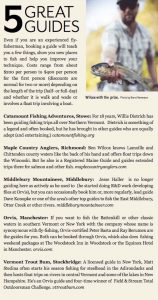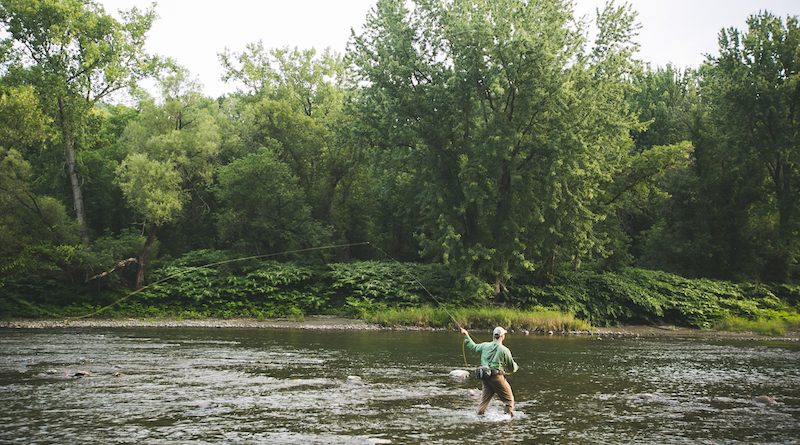May, Flies and Hungry Fish
In May, Ben Wilcox leaves off sugaring and heads to his favorite trout streams. Here, he shares (some of) his secrets for success.
“May is usually the best month to fly fish in Vermont,” says Ben Wilcox. “And the later in May, the better the fishing. But there are so many bugs out and so many hatches, it may take a lot of fly-tying and guessing before you figure out what insects the trout are going after.” For Wilcox, who has guided the likes of the president of Orvis, that means trying “pheasant-tailed flies, hares ear, prince nymphs, zug bugs, Hendrickson emergers, Frenchies, caddis larvae, pupa nymphs and stone flies.”
This year, with the cold temperatures and big snowpack, the fishing could be good well into June too, predicts Wilcox, who runs Maple Country Angler’s guide service out of Richmond. “I think after last year’s cold season where we never really got the super warm days, and with this cold spring, we’re going to have one of the best fly-fishing seasons in many years,” he says.
With the late snowpack, Wilcox advises that fishing earlier in the day will yield more success—especially if it’s sunny. “If there’s any sun snowmelt up in the mountains can make downstream waters murky. Look for clear pools, and when the water approaches 50 or 60 degrees, the fishing is usually the best” he says. He adds, “it’s good to have a nymph rod and a dry fly rod in May because the fish will be feeding at all levels.”
In late April 2018, Wilcox and fellow guide Jesse Haller, two of Vermont’s top fly fishermen, headed to Pennsylvania to compete in the Team USA Northeast Regionals.
2017 was Wilcox’s first time at the event. Competing on his own without a team to support him against some of the top fly fishermen in the East, Wilcox pulled in 20 fish over the four sessions (fishermen switch locations to even out the chances) to finish 10th overall. He then went on to finish 34th in the Nationals.
This year, though, he had little time for practice. “It’s been so cold out that we’re still sugaring. I’ve barely shed at all. I think my arm might fall off from casting,” he jokes. Still, he placed third catching 39 fish and earning him and Haller and their team, Stackmend, second place overall behind Team USA.. If he had one a final tie-breaker, Wilcox would have one the overall title.
“Ben is good, really good,” says Haller, who works for Orvis and took 15th in the contest.
Wilcox grew up skiing and hiking the flanks of Mount Mansfield. His grandfather tapped 3,000 sugar maples using a team of horses to collect the buckets of sap and bring them to the sugarhouse, a mile into the woods. His father, on retirement, followed suit. Wilcox seemed destined to go into the business too. Instead, after getting his B.A. in Business Administration at the University of Maine, he went to work in sales for Pepsi. In Maine, Wilcox also became a Registered Maine Guide (Vermont doesn’t have a similar program).
“I soon realized the corporate world was not the lifestyle I wanted,” he says. “And I missed Vermont.”
After six years, he came back and went to work with his dad, tapping the 26,000 trees on their Underhill property.
“When I moved back, I was bummed to find the trout population had plummeted,” he recalls. But  last season, something changed.
last season, something changed.
In April 2017, Wilcox headed out one day to fish a river that flows through his grandfather’s old farm, a minute from where he grew up. “When I was a kid, this river had a well-deserved reputation for producing big wild browns,” he wrote in his fishing report. “I recall so clearly standing on the bank with my dad and watching two huge brown trout holding under a log. I would fish the river frequently and always seemed to have good luck.
“I am unsure of what really happened, but in recent years, in the spring, before the river was stocked, my outings nearly always resulted in no fish. In fact, I don’t think I had caught a fish in the river for more than six years. After catching some wild fish in a small tributary last year, I decided I’d give it a try. When the wild brown took my fly, I was ecstatic. It was a great way to start my season.”
Living in Richmond, Wilcox likes to fish the Winooski where he goes for bass and trout in the summer and heads to some of the other rivers that spill into Lake Champlain for steelhead and landlocked Atlantic salmon in the fall. He chronicles the fishing conditions, the hatches, the flies he uses on his website—everything except the spots he heads to.
“Last year [2017] I saw more fly-fishermen on the river than I ever have and way more people in spots than I ever recall seeing. People are getting in on the sport, which is good, and more people are fly-fishing, which has less of an impact on the fish population since so many practice catch-and-release” he says. However, it does mean that he works harder to find his spots. “I sometimes have to drive a little farther and hit some waters that get overlooked. I don’t want to bring clients to fish next to other people. I don’t want to see other people.” If he sees someone else fishing, Wilcox follows etiquette and moves on, and he expects others to do the same.
In May 2017, Wilcox found himself, along with guide Matt Stedina, guiding Bill McLaughlin, the president of Orvis. “Yeah, that was a bit of pressure,” he says with a laugh. They were fishing the White River when Wilcox’s phone started buzzing. “I didn’t want to answer with clients around, so I waited until they were done,” he says. It turned out his wife had gone into labor one month early. He arrived at the hospital just 45 minutes before his second daughter was born.
That was the catch of the day.
Featured Photo Caption: Ben Wilcox, casting in his home waters. In spring 2018, he placed third in the Northeast Regionals.
Last updated May 22, 2019.


Pingback: Vermont Sports Magazine, May 2018